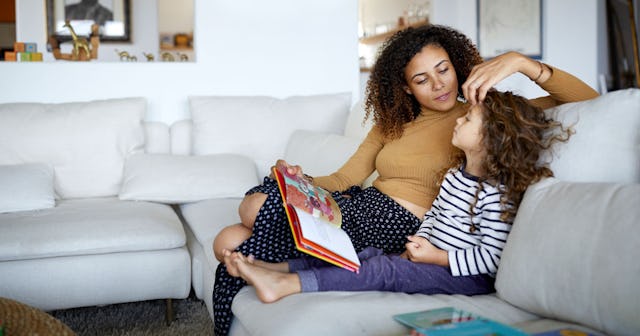From An Educator: 5 'Teacher Tricks' To Use When Reading To Your Kids

No matter where I am—the library, the doctor’s office, waiting to get my oil changed—I can always tell if the person I overhear reading aloud to kids is a teacher. Teachers just sound different.
When teachers read, it stands out to me, because they’re never just reading the words on the page. They’re interacting with the book and with the kids in a way that makes you pay attention. Teachers just seem naturally good at adding little ways to get kids to think about and engage with the story. They’re also most likely reading with different voices or with a vibrant expression that makes you want to stop and listen.
Within education circles, these techniques that teachers use are considered best-practices. Teachers want their students to be thinking about things like characters, chronology, plot, and setting in stories. They want their students to be asking themselves questions about the story to aid in their comprehension and problem-solving abilities. And they want their students to one day read with fluency themselves.
If you have no background in education, this might sound complicated to do yourself at home. However, adding some of these teacher-tricks into story time with your kids is much easier than you think and can lead to these same big benefits!
Here’s five easy ways you can start building some literacy skills for your kids while you read at home:
Teacher-Trick 1: “I wonder…”
While you’re reading with your kids, pause every now and then and make some “I wonder…” statements or questions. After you’ve modeled it a few times, encourage your kids to share some things they’re wondering too.
This can get kids thinking about cause and effect, making predictions, and patterns in stories. These kinds of questions can also build empathy and get kids to examine characters and their choices.
Example: When reading a story like “The Three Little Pigs,” stop after the second pig builds his house and the big bad wolf shows up. Say, “I wonder what will happen next!” and give your child some time to make some guesses. You could also ask questions like, “I wonder how the pig feels after his house is blown down?”
Teacher-Trick 2: “Why do you think…?”
Maskot/Getty
Like Teacher-Trick 1, asking “Why do you think…?” questions not only gets kids thinking about the story but also gives them a chance to deepen and demonstrate their comprehension of what’s happening.
Example: Sticking with “The Three Little Pigs,” some good questions could be:
“Why do you think the wolf blew down the house?”
“Why do you think the first pig built his house with straw?”
“Why do you think the third house didn’t blow down?”
Teacher-Trick 3: Fill in the Blank
When you’re reading a story that has repeating patterns or rhymes, try leaving out a word to see if your child can fill in the blank. This helps kids recognize the predictable patterns in stories and also helps them start to recognize and hear rhymes out loud.
Example: While reading a book like “Brown Bear, Brown Bear, What do You See?” Try leaving out the words “see” or “me” and see if your kids will fill it in. If your kids are older, leave out more words from the repeating phrases.
Teacher-Trick 4: Expression
MoMo Productions/Getty
Fluency is a really important topic within literacy. When kids read with fluency, that means their words flow. They read with the right cadence, pausing and stopping where they should, based on punctuation. They also read with expression, meaning their voice doesn’t sound flat, boring, or monotone. The best way you can help your kids develop this skill is for you to read with expression and fluency yourself!
This doesn’t have to be extreme, voice-acting work here. Just be silly and add some personality to the characters. Try to bring the story to life, giving characters’ different voices. Add suspense or excitement with your voice at appropriate places too.
Example: Any book with dialogue and multiple characters would work. Two of my kids’ favorites for silly, expressive reading are “Don’t Let the Pigeon Drive the Bus” and “Peanut Butter and Cupcake.”
Teacher-Trick 5: Examining Pictures
The illustrations in a book are not only entertaining in themselves, but they are also so important for teaching kids about context. When kids start to read on their own, teachers want them to use all sorts of context clues to uncover the meaning in the story and to start to learn how to read the words. Get your kids used to examining the pictures of the story to understand what’s happening, determine the setting of the story, and start the important work of decoding (or learning how to pronounce) the words.
Example:When reading “Corduroy,“ stop and ask your child what he or she notices about the picture of Corduroy sitting on the department store shelf. Your child might point out colors, shapes, objects, or characters. If some of the text of the story matches those words, point them out! You could share some things you notice to model this skill. Ask your child where the story takes place and point out the things in the picture that the text mentions.
Try one of these teacher-tricks out the next time you and your child are snuggled up for a story. I think you’ll be surprised with how easy they are to incorporate, and how much your child will wonder, learn, and laugh alongside you!